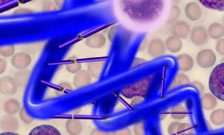Scientists discover mechanism of resistance to vital leukaemia treatment, opening door to new therapies

(Medical Xpress)—Research published in the journal Cancer Cell has revealed the mechanism by which leukaemia cells develop resistance to the ATRA (All-Trans-Retinoic Acid) treatment, used to treat an aggressive form of cancer called acute promyelocytic leukemia (APL: a fast-growing cancer in which there are too many immature blood-forming cells in the blood and bone marrow). The research is by Professor Eric So, Department of Haematological Medicine at King's College London, and colleagues, and was funded by the charity Leukaemia & Lymphoma Research.
APL is a subtype of acute myelogenous leukaemia (AML) characterised by the presence of a specific leukaemia-inducing nuclear protein called PML-RARa, which activates abnormal gene expression programmes in the cancer cells. APL represents five to eight per cent of AML in adults (approximately 200 new cases occur each year in the UK and 1500 new cases each year in the USA). The median age of diagnosis is approximately 40 years, which is considerably younger than the other subtypes of AML (70 years). Without proper medicine and treatment, APL is fatal.
The successful application of ATRA treatment for APL started in 1986 in Shanghai, China. It was soon widely adapted around the world. While ATRA alone induces a complete remission in the majority of the APL patients, patients will relapse and become resistant to the treatment. Recent refinements have improved results: ATRA is used in combination with low dose chemotherapy and more recently with Arsenic Trioxide, which have now led to long-term complete remissions in as high as 80 per cent of patients.
But while ATRA treatment revolutionised care for APL, and has been the paradigm of targeted therapy for leukaemia-inducing nuclear proteins, the underlying mechanisms remain largely unknown, and roughly 20 per cent of patients who enter into a complete remission will still relapse and become resistant to the treatment. Only half of these patients will be alive after three years. Also, while the success of ATRA treatment in APL sets the stage for targeted therapy of leukaemia-inducing nuclear proteins, retinoic acid (RA) treatment has so far been shown to be ineffective in treating other cancers. Thus cracking the mechanism of action of this drug is essential.
In this study, Dr So and colleagues discovered the accessory enzyme PHF8 as a critical molecular sensor for mediating ATRA treatment response in APL. Using a molecular biology approach, his group identified that PHF8 specifically bound to PML-RARa in response to ATRA treatment, and this interaction was required for eradication of APL cells. ATRA-resistant APL cells also had reduced level of PHF8. By activating the activities of PHF8 using a molecular biology approach or chemical intervention, it could resurrect ATRA-sensitivity to treatment resistant APL cells in both mouse models and human cell lines derived from APL patients. In contrast, its suppression led to ATRA-resistance.
In addition, they discovered that PHF8 is regulated by a specific type of protein modification, called phosphorylation. As a proof of principle experiment, Dr. So and colleagues demonstrated that pharmacological enhancement of PHF8 phosphorylation was able to sensitise treatment resistant APL cells to ATRA both in cell culture and in the whole animals. Dr So said: 'These results reveal a critical function of this class of accessory enzymes in mediating treatment and open up a novel avenue for overcoming treatment resistance in APL. The next stage of the research will be to identify the key molecules that affect the activity of PHF8, and to develop specific drugs that will promote the functions of PHF8 in mediating treatment response.'
In this study, a generic inhibitor (okadaic acid) that promotes PHF8 phosphorylation has shown an encouraging efficacy in inducing ATRA response in resistant APL cells. 'It is quite possible that specific and more effective drugs can be developed if we can improve the specificity of some of these generic inhibitors in the coming years,' said Dr So. 'In parallel, we are also trying to identify the key and tractable PHF8 regulators for the development of a new class of small molecule inhibitors effectively targeting the activity of PHF8.'














